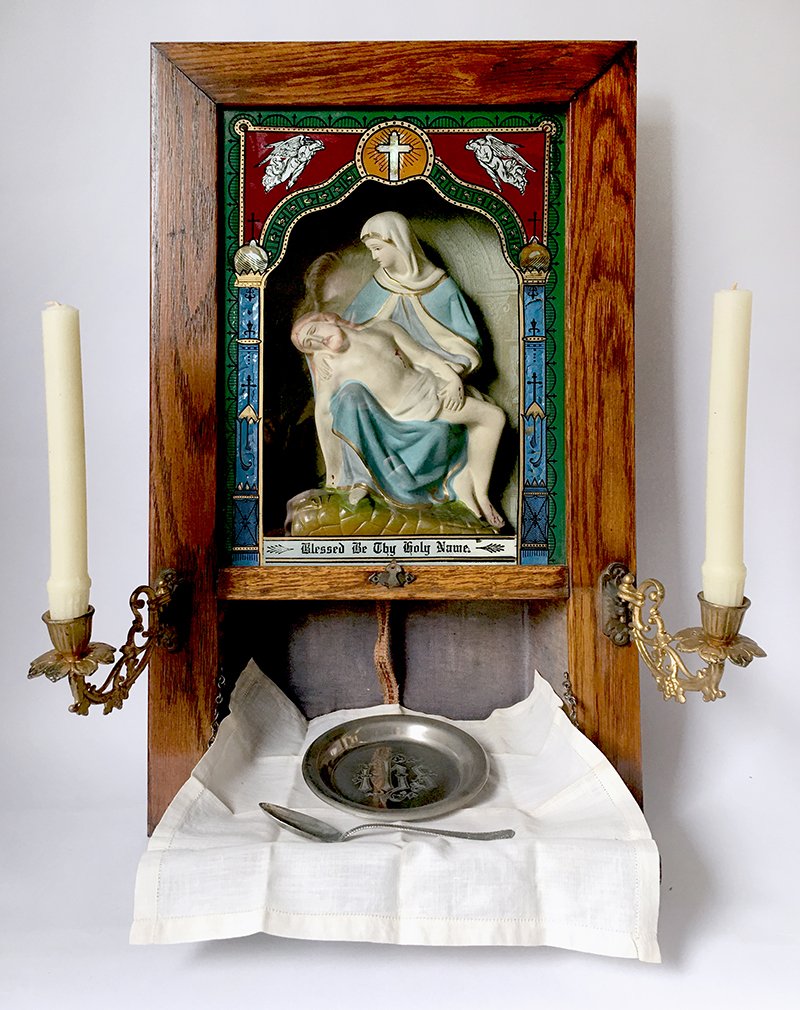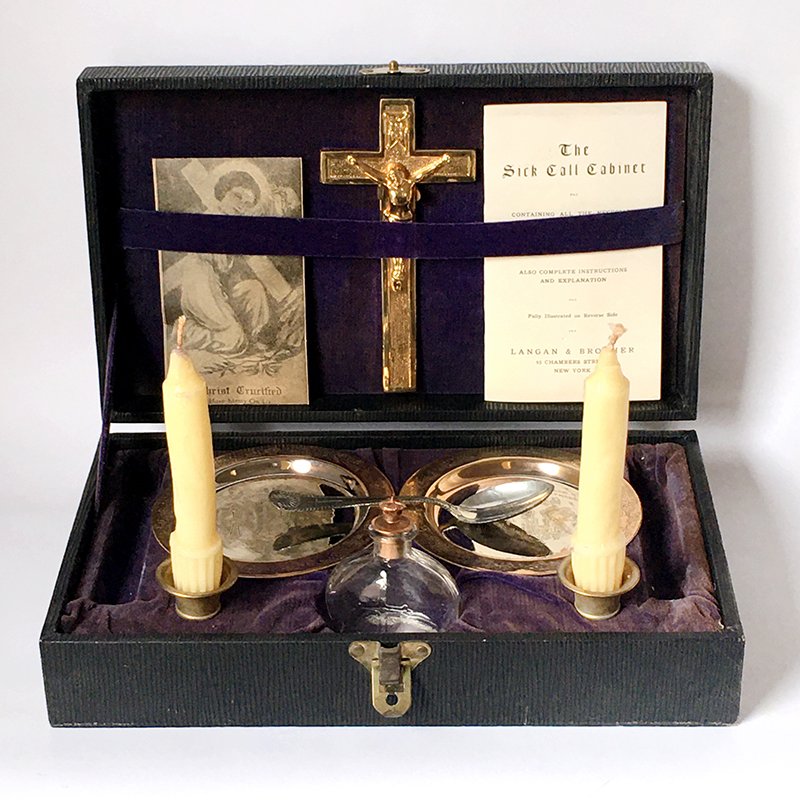“I was a Catholic boy, I went to church every Sunday. A church has a certain magic and mystery for a child. It still shows in how I arrange things. It’s always little altars.”
— Robert Mapplethorpe
OUR HOME HAVE BEEN TRANSFORMED into a safety zone, a barricade, a sanctuary against a new, invisible demon that threatens our very lives. The global pandemic of COVID-19 has limited travel, as well as many of the everyday meeting places that bring us in contact with neighbors, colleagues, friends and family. While our in-person exchanges have become restricted, the separation between our public and private lives have curiously merged. For some of us, office and school moved into our homes. Business and study continue via online platforms. Various associates are welcomed into our living rooms, kitchens, wherever we’ve set up our computers or laptops. Negotiating and sharing space, virtually and physically, is a new challenge. Some of us have thrived, enjoying connections that are more far-reaching, while others of us are experiencing an invasion into our privacy where personal boundaries become blurred.
Our spiritual refuges, our churches, temples, mosques, synagogues are among those places that have been altered or closed due to the pandemic. Fellowship is a masked affair and prayer partitioned. Our spiritual and emotional needs, let alone financial, are not often included in scientific calculations that call for prolonged self-isolation. To curtail the spread of virus we’ve limited gatherings and distance ourselves from each other. This year, our homes have served many more functions than ever before, or at least expanded the scope of those functions. With that, our awareness of home as a haven and a place of comfort and tranquility has been heightened.
The annual Curious Matter Holiday Installation looks to our personal collection of household devotions to reveal a theme that transcends our cultural connection to faith. Mining our spiritual roots and iconography, we look for clues to universal concerns. In past exhibitions, we’ve meditated upon personal saviors, family dynamics, and the sanctity of objects and places of worship. 2020 has led us to consider the many functions and meaning of home. Home is a comfort, a refuge, the place where we can express who we are, deeply and fully. That is the hope. Simply by closing the front door we might be able to keep the troubles and pestilence of the world at bay. But the window into our jobs and other responsibilities hovers closer than ever in the glowing screens that are all within easy reach. How can we create a place to meditate, to cordon off distractions, to quiet our minds and spirit?
The emotional significance and power in the symbols of religion have been harnessed and promoted by priests and practitioners for centuries—used to profound effect in the church or temple, the official place of worship. But the faithful also hope to bring a whisper of the sacred into their homes. Many spiritual traditions and cultures encourage the personal possession and use of various images, icons and totems that foster faith outside of the congregation. These items often take the form of the most popular or sentimental concepts of the religion. One glance at them and the faithful are instantly put in mind of their specific spiritual connections and aspirations. For those who believe, household devotions bring the spirit of the church and its covenant of protection and grace to their personal space.
In our Catholic tradition, the devout often set aside a special place of worship, or an altar, within the home. This may simply be an image of a saint tucked into the edge of a mirror frame. Or they might create an elaborate, room-sized shrine that rivals a cathedral chapel. The size and complexity are irrelevant to the purpose. It is the quality of the faith that matters. Still, an image, a cross, or an icon and a candle seem to be the prerequisites, something to gaze upon, to direct one’s prayers. Other devotional objects could include a bible, prayer beads, or a multitude of other personal objects that move the meditative mind into the realm of the sacred.
Unlike the official church altar, the purpose of which is to prepare the sacred meal in imitation of Christ’s Last Supper, the home altar does not usually contain the implements to handle and prepare the holy bread and wine. The home altar is generally set up for prayer and veneration and to that end, can be dressed more simply. The Curious Matter collection of household devotions could all be incorporated into home altars. But for this installation we’ve concentrated on particular items designed to serve the specific function of a home altar. These examples are popularly available to the faithful. A wall hung crucifix that slides open to reveal two candles and a bottle of holy water is a common and compact home altar. Others were designed to administer to the housebound and contain the paten, ciborium, corporal and purificator for the visiting priest to offer the sacrament of communion. These more elaborate altars housed in shrines also display sculptures of saints or Christ behind glass and were intended to be installed as a permanent fixture in the home. The altar items are stored behind a drop-down door that also functions as the altar proper. Another design housed in a small box, makes the altar portable to give the priest the ability to perform the sacrament of Holy Communion anywhere. It contains the necessities to hold the bread and water for the rite in the manner dictated by the Church.
The home altar isn’t unique to the Catholic tradition, or even other faiths. A place of meditation and contemplation within the home can serve those who through knowledge or belief question or reject a God, deities or other manifestations of the divine. The shape and content of the altar may be religious or secular. An array of seashells could be the focus of one’s meditation and reestablish a connection to the rhythms of nature and quiet day-to-day concerns. A wall of family photos enshrines and roots one in the security of tradition and an enduring connection to personal history. Anything you personally hold sacred can be elevated in a special place and venerated as an altar, be it recognized as a part of a traditional religion, a pagan idol or symbol, a collection from nature, or images of family. Your personal altar may be none of these. It can simply be a special spot where you can go to internally withdraw and contemplate.
Each year with the aid of the iconography of the religion we were taught as children, we identify the most thoughtful and generous aspects of our shared humanity. For us, those lessons came via the stories of the life of Christ, his love and his suffering. Some visitors who have seen our collection of Catholic devotions, or have visited our annual holiday exhibition, find it impossible to separate transgressions of the church from these various objects and images, each a reminder of an abuse or injustice. Those human and institutional failures are not lost on us. Our own relationship to the institutional church is one of flux and reservation at the least. However, the actions of people and their personal failure to honor their vows do not reduce the messages of humanity and love that come from the Word. We at Curious Matter look at these objects through a lens of individual acts of faith and devotion. They are vessels through which to find inspiration to articulate the most pure and exquisite acts of selflessness and kindness that transcend our religious tradition. What we wish for everyone is a calm mind, secure home, kind fellowship and good health. The circumstances of this extraordinary year have kept us distant, but not in our hearts. Our holiday installations often speak of the light we wish to nurture through this dark time of year. It seems we’ve confronted a darkness that has lasted more than just a season. We long for and hope 2021 brings you profound joy and that we will be together again soon.
AS EVER,
RAYMOND E. MINGST | ARTHUR BRUSO
CO-FOUNDERS, CURIOUS MATTER
Home Altars: creating a personal refuge
The 2020-2021 Curious Matter Holiday Installation
December 24, 2020 – January 29, 2021



